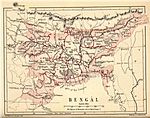
Back পশ্চিমবঙ্গের ইতিহাস (১৯৪৭–বর্তমান) Bengali/Bangla पश्चिम बंगाल का इतिहास Hindi Արևմտյան Բենգալիայի պատմություն Armenian مغربی بنگال دی تریخ PNB История Западной Бенгалии Russian மேற்கு வங்காள வரலாறு Tamil مغربی بنگال کی تاریخ Urdu
| History of Bengal |
|---|
 |
| History of West Bengal |
|---|
 |
| Part of a series on |
| Bengalis |
|---|
 |
The history of West Bengal basically refers to the history of the western part of Bengal, located in the eastern part of the Indian subcontinent. Evidence of human settlement has been found in West Bengal about 42,000 years ago. The presence of human settlement of that period has been found in the Ayodhya Hills of West Bengal.[1][2][3] By 2,000 BCE, settled life had increasingly spread of human civilization in the Damodar-Ajay River Valley, which was contemporary with the Harappa-Mahenjodaro civilization.[4][5] The southern part of West Bengal witnessed the presence of the Vanga kingdom between 1100 BCE and 350 BCE, which was contemporary with the Vedic civilization of northern India.[5]
Among the Mahajanapadas, Magadha became powerful around 350 BCE, at that time rulers of the Nanda dynasty of Magadha incorporated the territory of West Bengal into their empire. West Bengal was under the rule of all Magadha-centric empires after the Nanda Empire. Tamralipta in West Bengal was the main seaport of the Magadha-centered Maurya empire.[6] Most of the West Bengal's territory was ruled under the Gupta empire, that arose in northern India after the collapse of the Magadha-centric empires.
In Bengal, the Gaur kingdom was established in 690 AD, which spread across West Bengal and present-day Bangladesh. Gaur is often referred to as the first well-established independent political entity in Bengal.[7] After this kingdom, the Pala empire in 750 AD and the Sena empire in 1070 AD respectively emerged across West Bengal. Both of these empires were mainly Bengal-centric.
Islamic conquests were established in West Bengal as early as the 13th century. At this time Bengal along with West Bengal was included in the Ghaznavid empire. West Bengal was ruled under the Delhi Sultanate from the 13th to the 14th century and the Bengal Sultanate from the 14th to the 16th century. In the 16th century, after the fall of the Bengal Sultanate, West Bengal came under the Mughal empire.
Murshidabad in West Bengal was the capital of independent Nawab Bengal (1717–1765). In 1765, the British took over the control of Bengal including West Bengal from the Nawabs of Bengal.[8] The Bengal Presidency of the British Indian Empire was divided into West Bengal and East Bengal in August 1947; West Bengal was included in the Dominion of India and gained independence as an Indian state.
- ^ Cite error: The named reference
eisamay1was invoked but never defined (see the help page). - ^ Cite error: The named reference
Mahadebbera-Kanawas invoked but never defined (see the help page). - ^ Cite error: The named reference
telegraphindia1was invoked but never defined (see the help page). - ^ Pradeep Mukherjee (13 December 2022). "প্রায় চার হাজার বছর পূর্বের সভ্যতার নিদর্শন বর্ধমানের 'পাণ্ডু রাজার ঢিবি '" [The 'Mound of Pandu Raja' in Bardhaman is a sign of the civilization of about four thousand years ago.]. www.eisamay.com (in Bengali). Ei Samay. Retrieved 8 August 2023.
- ^ a b Bharadwaj, G (2003). "The Ancient Period". In Majumdar, RC (ed.). History of Bengal. B.R. Publishing Corp.
- ^ Haraniya, Krutika (25 June 2017). "Tamralipti - The Ancient Copper Port". www.livehistoryindia.com. Retrieved 9 August 2023.
- ^ "প্রাচীন বাংলার ইতিহাস" [History of Ancient Bengal] (PDF). www.ebookbou.edu.bd (in Bengali). Retrieved 8 August 2023.
- ^ Paul, Gautam. "Murshidabad History - Mir Muhammed Jafar Ali Khan". murshidabad.net. Archived from the original on 8 April 2016. Retrieved 9 August 2023.